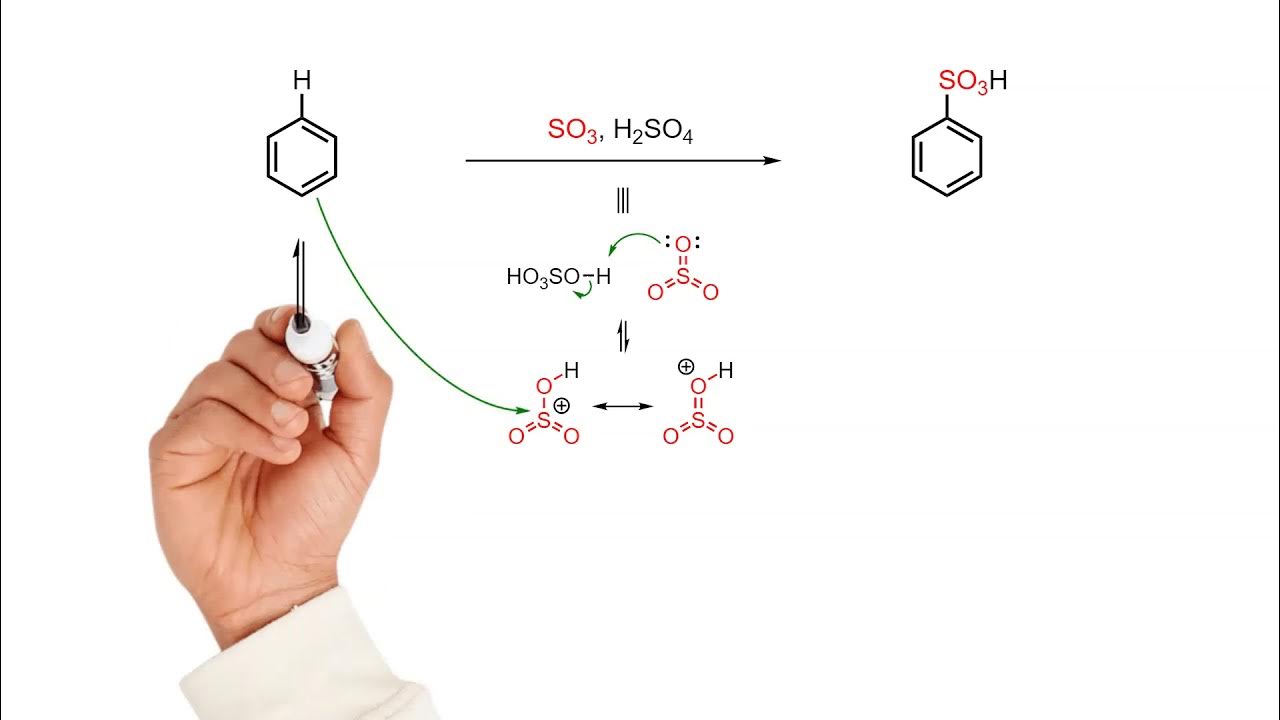BENZENA DAN AROMATISITAS [KIMIA ORGANIK]
Summary
TLDRThis instructional transcript explains benzene and aromaticity: its discovery, C6H6 structure, resonance, and delocalized π-electrons that create a flat aromatic ring. It covers Kekulé structures, aromaticity criteria, and common substituents and naming conventions (ortho/meta/para, vinyl vs. benzyl). Numbering and priority rules for multiple substituents are clarified. The lecture then details key electrophilic aromatic substitution reactions—halogenation, nitration, Friedel–Crafts alkylation and acylation—highlighting catalysts (Fe/FeX3, AlCl3, H2SO4), formation of electrophiles, reaction steps, and typical products like bromobenzene, nitrobenzene, toluene derivatives, and acetophenone.
Takeaways
- 😀 Michael Faraday first synthesized benzene in 1825, and it has the molecular formula C6H6.
- 😀 Benzene is an unsaturated aromatic hydrocarbon due to its resonance structure, with alternating single and double bonds between carbon atoms.
- 😀 Benzene undergoes resonance, where the double bonds shift positions, creating a delocalized electron structure that forms an aromatic ring.
- 😀 Benzene’s aromaticity requires a cyclic, flat structure with p orbitals perpendicular to the plane of the ring, allowing electron delocalization.
- 😀 Substituted benzene compounds have specific names based on their substituents: for example, phenol (benzene + OH), toluene (benzene + CH3), and aniline (benzene + NH2).
- 😀 The position of substituents on the benzene ring is identified using the terms ortho (1,2), meta (1,3), and para (1,4).
- 😀 Benzene can form different compounds depending on its substitutions, such as benzoic acid (C6H5COOH) or benzaldehyde (C6H5CHO).
- 😀 The general naming convention for substituted benzene involves using prefixes (ortho, meta, para) for two substituents, and numbers for more than two substituents.
- 😀 Benzene undergoes electrophilic substitution reactions, such as halogenation, nitration, alkylation, and acylation, which add functional groups to the ring.
- 😀 In halogenation, benzene reacts with halogens (like Br2 or Cl2) in the presence of a catalyst (Fe or FeCl3), substituting a hydrogen atom with a halogen atom.
- 😀 In nitration, benzene reacts with nitric acid (HNO3) and sulfuric acid (H2SO4) to form nitrobenzene (C6H5NO2) by substituting a hydrogen atom with a nitro group (NO2).
Q & A
What is the molecular formula of benzene, and why is it considered an aromatic compound?
-The molecular formula of benzene is C6H6. It is considered an aromatic compound because of its unique structure, where the electrons in the carbon-carbon bonds are delocalized, forming a conjugated system of alternating single and double bonds that contribute to its stability and aromaticity.
Who first synthesized benzene, and in what year?
-Benzene was first synthesized by Michael Faraday in 1825.
What is resonance in the context of benzene's structure?
-Resonance in benzene refers to the ability of the double bonds in its structure to shift and move. This means that the positions of the double bonds are not fixed, and the actual structure is a hybrid of multiple resonance forms. This delocalization of electrons contributes to benzene’s stability.
What is the significance of the P orbital in the aromaticity of benzene?
-Each carbon atom in the benzene ring has a P orbital that is perpendicular to the plane of the ring. These P orbitals overlap and allow for the delocalization of electrons around the ring, contributing to the compound's aromaticity and stability.
What are the common names of some benzene derivatives mentioned in the script?
-Some common names of benzene derivatives include phenol (benzene with an -OH group), toluene (benzene with a methyl group), aniline (benzene with an -NH2 group), and benzoic acid (benzene with a carboxyl group, -COOH).
What are the different prefixes used to indicate the relative positions of substituents on a benzene ring?
-The prefixes used to indicate the positions of substituents on a benzene ring are 'Ortho' (for substituents at positions 1 and 2), 'Meta' (for substituents at positions 1 and 3), and 'Para' (for substituents at positions 1 and 4).
How is benzene’s substitution reaction with halogens (like Cl2 or Br2) catalyzed?
-Benzene’s substitution reaction with halogens requires a catalyst, typically FeCl3 or AlCl3. The catalyst facilitates the formation of an electrophile (e.g., Cl+ or Br+), which then replaces a hydrogen atom on the benzene ring, resulting in the formation of a halogenated benzene.
What is the process of nitration in benzene, and what products are formed?
-In nitration, benzene reacts with nitric acid (HNO3) in the presence of sulfuric acid (H2SO4) as a catalyst. This reaction forms nitrobenzene (C6H5NO2) by substituting a hydrogen atom with a nitro group (NO2+).
What is the Friedel-Crafts alkylation reaction, and how does it work?
-The Friedel-Crafts alkylation is a reaction where an alkyl halide (such as RX) reacts with benzene in the presence of a Lewis acid catalyst (like AlCl3). The catalyst generates an electrophilic alkyl group (R+), which then substitutes a hydrogen atom on the benzene ring, forming an alkylated benzene.
What happens during the acylation reaction of benzene?
-In the acylation reaction, benzene reacts with an acyl chloride (RCOCl) in the presence of a catalyst like AlCl3. The acyl group (RCO+) substitutes a hydrogen atom on the benzene ring, forming an aryl ketone (such as acetophenone, C6H5COCH3).
Outlines

Dieser Bereich ist nur für Premium-Benutzer verfügbar. Bitte führen Sie ein Upgrade durch, um auf diesen Abschnitt zuzugreifen.
Upgrade durchführenMindmap

Dieser Bereich ist nur für Premium-Benutzer verfügbar. Bitte führen Sie ein Upgrade durch, um auf diesen Abschnitt zuzugreifen.
Upgrade durchführenKeywords

Dieser Bereich ist nur für Premium-Benutzer verfügbar. Bitte führen Sie ein Upgrade durch, um auf diesen Abschnitt zuzugreifen.
Upgrade durchführenHighlights

Dieser Bereich ist nur für Premium-Benutzer verfügbar. Bitte führen Sie ein Upgrade durch, um auf diesen Abschnitt zuzugreifen.
Upgrade durchführenTranscripts

Dieser Bereich ist nur für Premium-Benutzer verfügbar. Bitte führen Sie ein Upgrade durch, um auf diesen Abschnitt zuzugreifen.
Upgrade durchführen5.0 / 5 (0 votes)






